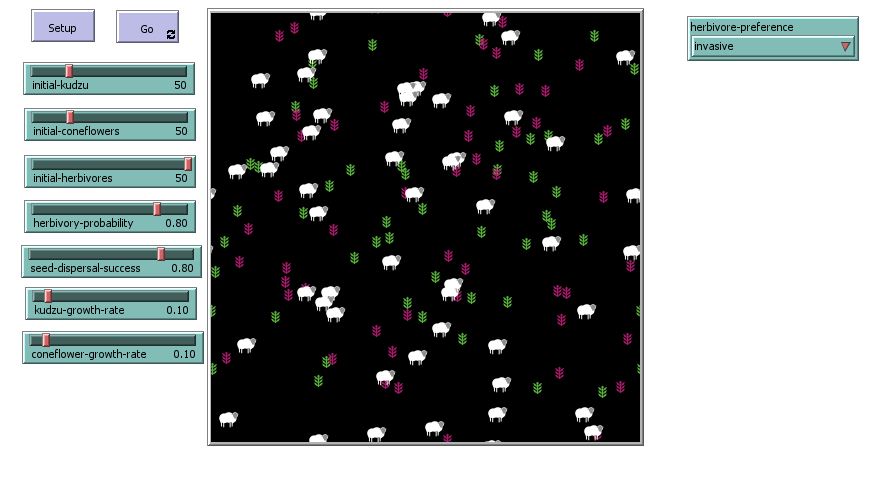Garden simulation
Title: Invasive Plant Species vs. Native Plants vs. Herbivores
Author: Jan César (cesj05)
Method: Agent-based model
Tool: NetLogo
Contents
Introduction and problem definition
Nature provides us with many interesting competitions. Whether it is predator vs. prey or invasive plant species vs. native plant species vs. herbivores (this simulation), it is a good topic for an agent-based simulation. The goal of this simulation is to understand the dynamics of competition between invasive plant species and native plants in a shared environment. The result will show how the shared environment is filled with invasive/native plants accordding to the set up.
Model and Method
The garden is randomly populated with a mix of invasive and native plants. There are also multiple herbivores placed around the area. The is also set up resource level for each patch.
Environment
Each patch represents a piece of land that can grow either a native or invasive plant. Plants compete for resources on each patch and must face the danger of multiple herbivores placed around the area.
Agents
Kudzu (Invasive)
growth-rate: probability of reproducing if resources are sufficient. seed-dispersal-range: how far new kudzu can spawn from the parent. resource-needs: minimum resources required to survive or reproduce.
Coneflower (Native)
growth-rate: probability of reproducing if resources are sufficient. seed-dispersal-range: smaller than kudzu’s. resource-needs: lower than kudzu’s, reflecting different resource tolerance.
Herbivores
preference: which plant they are more likely to eat (invasive, native, or none). energy: increases by eating, decreases each turn (if it hits 0, the herbivore dies).
Variables
- initial-kudzu - Number of invasive plant at the start of the simulation
- initial-coneflowers - Number of native plants at the start of the simulation
- initial-herbivores - Number of herbivores at the start of the simulation
- herbivory-probability - Probability that a herbivore successfully eats a plant upon encountering it
- kudzu-growth-rate - Probability that invasive plant try to reproduce each tick if it has enough resources
- coneflower-growth-rate - Probability that native plants try to reproduce each tick if they have enough resources
- herbivore-preference - Chooser which tells herbivores which plant to prefer when they encounter multiple possibilities
UI
Simulation steps
Setup Phase
Clear the world (remove any previous data)
Set up patches
Initialize each patch’s resource-level to a random or chosen value, and set occupant = "none".
Create Kudzu
Generate initial-kudzu turtles of breed kudzu. Place each on a random patch that isn’t blocked. Set each turtle’s growth parameters (growth-rate, resource-needs, seed-dispersal-range). Mark the patch occupant as "kudzu".
Create Coneflower
Same steps as kudzu but for initial-coneflowers. Lower seed-dispersal-range, possibly a lower or different growth-rate. Mark occupant as "coneflower".
Create Herbivores
Generate initial-herbivores turtles. Place them randomly on valid patches. Give them default energy, set preference from a chooser (invasive/native/none).
Go Phase (Repeated Each Tick)
Herbivores Move and Eat (move-and-eat)
Each herbivore picks a random direction or a nearby patch. If it encounters a plant occupant on its patch, check if random-float 1.0 < herbivory-probability. If yes, remove the plant (occupant = "none"), and increase the herbivore’s energy. Subtract 1 energy each tick. If it goes to 0, the herbivore dies.
Plants Grow and Reproduce (grow-and-reproduce)
Each plant checks the patch’s resource-level. If resource-level >= resource-needs, it survives. It may also reproduce if random-float 1.0 < growth-rate. Reproduction calls disperse-seeds to create a new plant in a nearby patch (defined by seed-dispersal-range). The new seed’s success is tested against seed-dispersal-success. If it fails, no new plant is created. If the patch doesn’t have enough resources, the plant dies (occupant = "none").
Resource Regeneration (resource-regeneration)
Each patch’s resource-level increments slightly each tick, up to a maximum (e.g., 1.0).
Increment Ticks
tick advances the simulation clock by 1.
Results
The results of the simulation may vary depending on the setup. Below is a list of four possible outcomes observed in the simulation:
Kudzu Dominates
Kudzu’s faster growth and bigger dispersal radius let it outcompete coneflower, especially if herbivores favor native plants or herbivory-probability is low.
Coexistence
Both species persist in different patches when resource levels are balanced and herbivores exert moderate pressure on each species.
Kudzu Fails
If herbivores strongly target invasive plants (kudzu) or resources are too scarce for its high demands, coneflower survives while kudzu dies out.
Near-Extinction
Under extreme conditions (e.g., very high herbivory or poor resources), either one or both plant species may vanish, potentially leaving empty patches if neither survives.
Conclusion
The simulation successfully simulates multiple scenarios and results. The result are depending purely on the setup of variables and therefore it is up to the user to change the outcome.
NetLogo File
Sources
For Kudzu (Pueraria montana):
Forest Service, U.S. Department of Agriculture. (n.d.). Pueraria montana var. lobata: Kudzu. Retrieved from https://www.fs.usda.gov/database/feis/plants/vine/puemonl/all.html
National Center for Biotechnology Information. (2024). PMC Article on Kudzu Growth Dynamics. Retrieved from https://pmc.ncbi.nlm.nih.gov/articles/PMC9824185/
Wikipedia contributors. (n.d.). Kudzu in the United States. Retrieved from https://en.wikipedia.org/wiki/Kudzu_in_the_United_States
For Purple Coneflower (Echinacea purpurea):
USDA Natural Resources Conservation Service. (n.d.). Plant guide: Echinacea purpurea. Retrieved from https://plants.usda.gov/DocumentLibrary/plantguide/pdf/pg_ecan2.pdf
Plant Delights Nursery. (n.d.). Purple Coneflower (Echinacea purpurea). Retrieved from https://www.plantdelights.com/blogs/articles/purple-coneflower-echinacea-purpurea-plant
USDA Natural Resources Conservation Service. (n.d.). Echinacea purpurea Fact Sheet. Retrieved from https://plants.usda.gov/DocumentLibrary/factsheet/pdf/fs_ecpu.pdf
